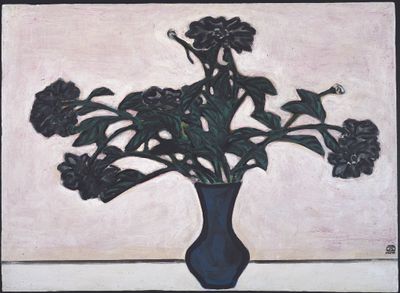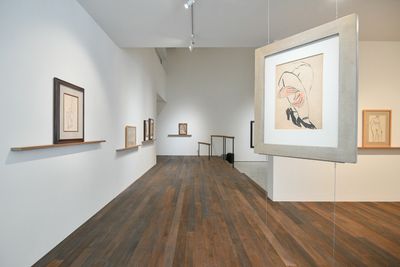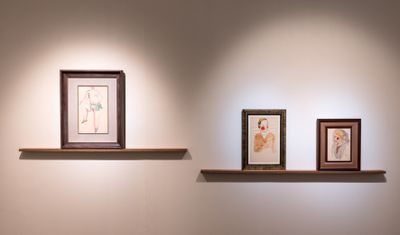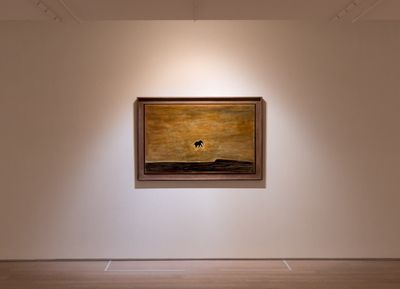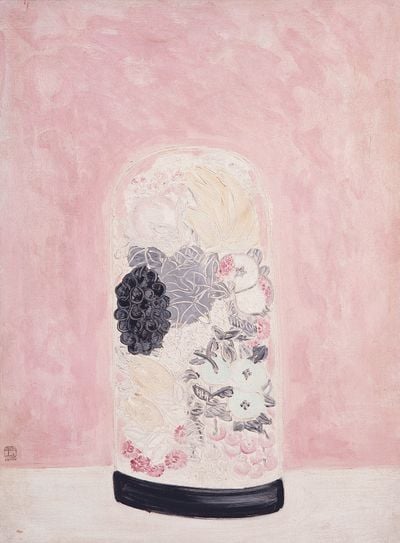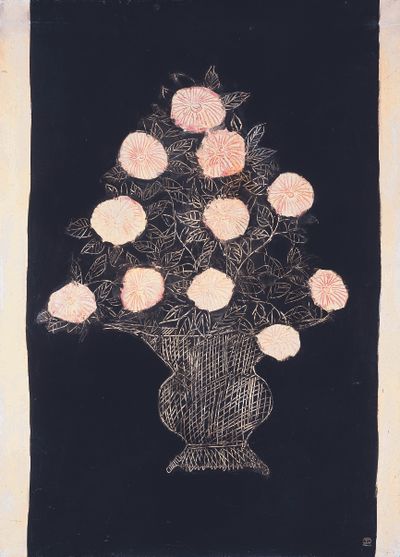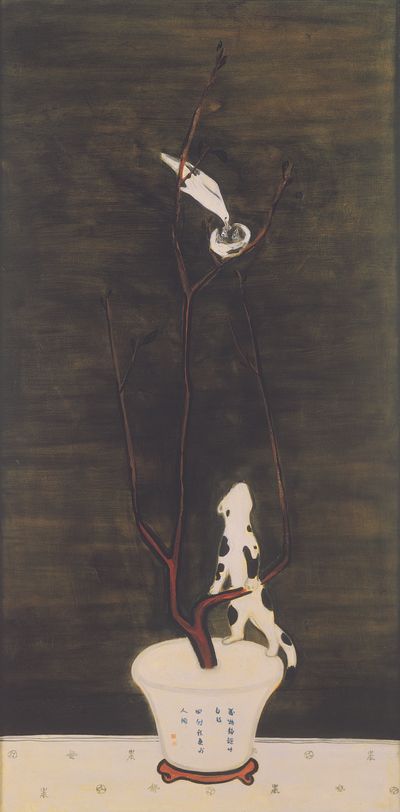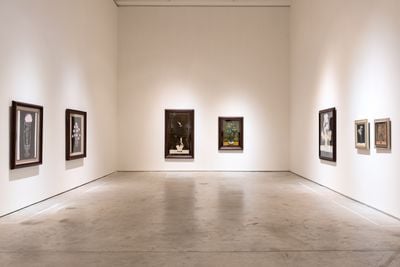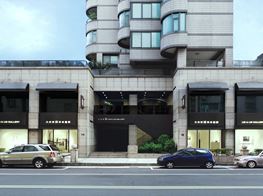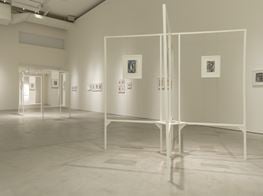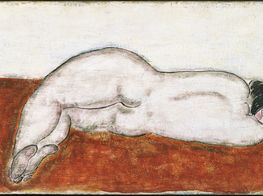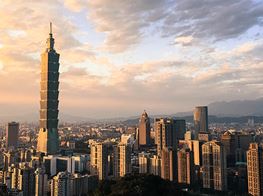Sanyu: An Introduction to a Modern Master
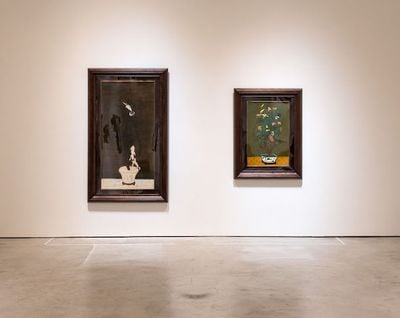
Sanyu, Cat and Birds (c. 1950s). Oil on masonite. 154 x 77 cm; Still Life of Flowering and Fruit Plant with a Green Ground (c. 1950–1965). Oil on masonite. 92 x 60 cm. Installation view: Sanyu's Hidden Blossoms: Through the Eyes of a Dandy, Tina Keng Gallery, Taipei (24 March–29 April 2018). Courtesy Tina Keng Gallery, Taipei.
Sanyu's Still Life of Flowering and Fruit Plant with a Green Ground, an oil on masonite panel dated between 1950 and 1965, presents a plant brimming with aspirations of wealth, or in the artist's case, memories of it.
Painted against a rich olive backdrop, Chinese symbols of good fortune, from peaches to pomegranates, grow from branches amid green leaves, blossoms, a small bird, and a few butterflies. The plant is potted in a fine ceramic Ming dynasty planter sitting on a mustard surface, on which ideograms are marked with fine lines, each representing one of the three attributes of a good life: happiness, prosperity, and longevity.
In this one composition, we see the life that a young painter born into a wealthy Szechuan family in 1901 left behind when he travelled to Paris in 1921.1 (Sanyu's elder brother, Chang Shufang, founded the successful Dehe Silk Factory in 1902.) What we also see is a painting that expresses the historical shift that Sanyu embodied as a man born in the Qing dynasty, and whose life ended somewhere between the histories of the Republic of China and the People's Republic, penniless, alone, and far from home.
Sanyu landed in Paris after stints in Japan and then Shanghai. He stayed in the former city for roughly two years with Chang Bicheng, another elder brother who was studying engineering at Tokyo's Waseda University (he was one of 12 children). All that is really known of his time there was that his calligraphy was published in a Japanese magazine, though Lavender Au suggests that Sanyu, like others of his generation, was drawn to Japan's embrace of modernisation.2 Returning to Shanghai, he designed packaging and advertisements for Ixin Toothbrush Company, founded by Bicheng.
Though among the wave of students who travelled to France under the government-sponsored work-study programme organised by Cai Yuanpei, chancellor of Peking University, Sanyu had the money to go about his experience in a more freestyle way. He mingled with both Chinese and international groups in the Parisian scene, revelling in a dandy-ish, bohemian life.3 (As Au chronicles, he even married 'a minor Parisienne aristocrat', befriended Alberto Giacometti, and apparently had his portrait painted by Picasso himself.4)
He ended up in Berlin for two years before returning to Paris in 1923 and settling there, during which time he became part of the short-lived Heavenly Dog Society, founded in 1921 by Chinese writers and artists in Europe to counter the Heavenly Horse Society in Shanghai, founded a year earlier by Liu Haisu. (Where the two groups differed in terms of their relationship with western art and their intentions to revolutionise traditional Chinese painting, was that the Horse Society celebrated impressionism, while the Dog Society favoured realism.5)
In Paris, Sanyu took figure-drawing classes at Académie de la Grande Chaumière in Montparnasse, which offered an experimental alternative to the academic constraints of the École des Beaux-Arts. It was here that Sanyu integrated western artistic traditions with the skills he developed as a student of his father, a painter said to have been recognised for his depiction of lions and horses, and then of the renowned Szechuan calligrapher Zhao Xi.
Demonstrating a confident line in his approach to the figure, using 'the calligraphy brush to paint quick sketches' as his contemporary Pang Xunqin recalled, the majority of his studies from this time feature voluptuous women with—as poet Xu Zhimo's described them—'cosmically grand legs'.6
A selection of these early ink drawings were among the 40 works gathered from around 20 private collections, including the Taipei-based Fubon Art Foundation, for Sanyu's Hidden Blossoms: Through the Eyes of a Dandy, a non-selling show curated by Hsu Fong-Ray for Tina Keng Gallery (24 March–29 April 2018).
Functioning like a mini-retrospective, the exhibition mapped out this enigmatic artist's creative life, from his early works on paper from the 1920s—including a fantastic 1929 ink, charcoal and watercolour study of a robust nude woman wearing nothing but a flimsy green tutu and matching shoes (Nude with Green Shoes)—to an oil on masonite painting of a lone elephant walking along a vast, ochre landscape (Elephant, c. 1960s), one of his final pieces. The animal in the landscape is a common motif in Sanyu's practice, depicted as a small, solitary, yet potent figure in a monochromatic expanse; a nod to the artist's love of animals in general, and horses in particular. (Though cats often appear, too.)
The exhibition placed a special focus on the 1930s and 1940s, which Hsu Fong-Ray describes as the artist's most prolific decades.7 Sanyu started working with oil on canvas in 1929: the time of the Great Depression, when the financial support from his family in China dried up. He was forced to re-evaluate his approach to selling his art—in the past he preferred to give it away, and had no trust for dealers—and began working with French dealer, collector, and author Henri-Pierre Roché, whose collection included Picasso, Braque, Modigliani, and Duchamp.
It is said that Roché made an important impact on the artist's work, even if their relationship lasted only three years.8 (Sanyu's financial troubles drove them apart.9) For one, Roché not only encouraged Sanyu to explore oil painting, but to engage in printmaking. The artist created three copperplate illustrations for a book of poetry by T'ao Tsien that was published by Editions Lemarget in 1930, with a preface by Paul Valéry; the same year he gained entrance to the annual Salon de Tuileries exhibition.10 By 1931, Roché had amassed 111 paintings and 600 drawings by the artist.11
Paintings made during this time are referred to as works from Sanyu's so-called pink period: defined by minimalist canvases rendered in a colour scheme mainly of pink, black, and white, with some diversions. Influences from his calligraphy background are evident in the layering he applied to his surfaces, consisting of a base colour, a second layer that uses the 'flying white' or 'feibai' technique, which leaves lines left by widening brush hairs, and the use of dry brush to add details in the image.12
He also made use of a scratch tool or palette knife to mark lines into the paint. A particularly stunning example of this sgraffito technique in the Tina Keng show was Marriage Bouquet (c. 1930s). Against a pink backdrop and white ground is a bell jar that contains an array of pink, black, and white flowers, their details all carved into the paint. The result is sculptural, through which the blossoms create the volume of the jar itself, as if in relief.
To see these paintings in person is to observe how precisely the artist managed to maintain a flat, two-dimensional effect without losing a sense of volume; the result of a technical marriage where the essence of ink painting on paper is incorporated into the thickness of oil on canvas. The 1932 White and Pink Chrysanthemums in a Navy-Black Background, for example, presents 11 pink flowers that appear like rosy orbs against a black surface, the details of the vase and leaves 'etched' in with scratchy white lines.
The balance between western and eastern techniques and traditions is ever-present in such marks. Take White Peonies and Four Ponies (c. 1930s), which depicts an arrangement of flowers that sits squarely on an orange rectangle that denotes a surface, on which Han-dynasty style flying horses have been scraped in with fine lines—an echo of the artist's experience with etching that similarly recalls the incised lines of decorated Cizhou ware in China.13
In his later compositions, this technical and cultural equilibrium becomes more refined. The bodies that the artist once rendered in fine ink strokes on paper are transposed onto masonite, taking on a Matissean form, outlined with thick dark lines, forming flesh-coloured shapes. One such painting in Sanyu's Hidden Blossoms was Bather (c. 1950s–60s), in which a woman with her back to the viewer sits on a table in a classic pose, a white wash obscuring everything around her.
Bather was created following Sanyu's trip to New York City, where he travelled in 1948 only to meet with very little success, despite his flatmate at the time, Robert Frank, organising a show of 29 of Sanyu's paintings at the Passedoit Gallery in 1950. (Frank and Sanyu had arranged a studio-swap, but by some twist of fate, Frank ended up staying in the city.)
Throughout his career, the artist struggled to gain critical recognition—one review of a 1934 exhibition at Amsterdam's Kunstzaal Van Lier, organised by composer Johan Franco, described Sanyu's paintings as 'decorative and flat'.14 For Sanyu, however, perhaps this was the point. 'All that my works declare is simplicity', he said.15 Art critic Max Jacob described his work as having 'a precise and pure power' that combines 'intellect and technique.'16
Robert Frank recalls Sanyu constantly declaring that he was over painting, preferring to spend his time promoting a sport he invented in the 1930s: a hybrid between ping pong and tennis he called 'ping-tennis', which the French government, in 1958, considered incorporating into primary and secondary school curricula.17
While Sanyu left New York City without selling a single work, he did gain a lifelong friend in Frank; an intriguing and touching encounter between an artist from the old world and one from the new. (Sanyu gifted Frank the paintings he couldn't sell in New York, and Frank sold them in 1997 to benefit the Andrea Frank Foundation, which subsequently founded the Sanyu Scholarship Fund at Yale University in 1998 to support Chinese students of art.)
After returning to Paris, Sanyu's practice shifted again, with the artist creating stylised arrangements that spoke directly to traditional Chinese themes, marking a retreat into realms of wistful remembrance. Take the oil on masonite Cats and Birds (1950s), which the artist showed at Salon des Independents in 1955—the second in three consecutive years that he exhibited in the Salon.18 A bird tends to its chicks nestled in the bare branches of a barren plant growing out of a Ming planter, on which a poem by Song dynasty scholar Cheng Yi is written: 'To quiet a mind, all things reflect its innate nature, remain equanimous through the changing of seasons'. In a way, these later works reflect a man coming to terms with his life by maintaining the study that put him on his path in the first place.
Towards the end, Sanyu reportedly spent time with a younger generation of artists in Paris. But while he was known for his quiet humour, it is noted that no one really knew him. Nevertheless, he did leave some clues behind. In one 1945 article he published in Parisien Libéré, titled 'Reflections of a Chinese Painter on Picasso', he offers his impressions of Picasso's work that, knowingly or not, could reflect on his own. 'It is no longer just painting but something colossal and grand. It is a python as long as the Great Wall of China, a mosquito as large as the Pyramids, an athlete who lifts mountains, a thousand fireflies in the dead of the night', he wrote.19 When it came to the subversion of form, Sanyu continued: 'the deformation in Picasso's works is simply a first step. Our race is too old, our bodies too fragile, our life too short.'20
Sanyu died in August 1966 at the age of 65. He was found lying in his bed at home with a book propped on his chest and an application for French citizenship filled out nearby. (A result, reportedly, of gas inhalation after not turning his stove off properly the night before.) Two years earlier, he shipped some 42 oil paintings to Taiwan for a solo exhibition at the Museum of History in Taipei that was organised around an offer that the minister of education for the Republic of China, Huang Jilu, made in 1963: for Sanyu to teach at Taiwan's National Normal University. Huang wired 400 US dollars to pay for Sanyu's passage; but he is believed to have spent it—or some of it at least—to visit Egypt; a journey that would see him change, according to some accounts, his ROC passport to a PRC one to enable his journey, given that Egypt had formally recognised the People's Republic of China in 1956.
Sanyu was effectively left stranded with no money, unable to travel to Taiwan.21 This sense of being cut adrift continued when he was interred in an unmarked grave in Paris that would have been lost upon the expiry of its lease in 1996, had Robert Frank not sought it out just before it did, and renewed it for another 30 years.
Yet, like those in history whose contributions were left unrecognised in life, Sanyu's legacy has grown in death, with the artist finding an unofficial custodian in Taiwan, the place that had offered him a future. The National Museum of History in Taipei has held six retrospectives of the artist's work in 1978, 1984, 1990, 1995, 2001, and 2017; while a 1988 China-Paris exhibition at the Taipei Fine Arts Museum is credited as the event where Taiwan's art dealers discovered him and started building his market.22 In 1992, Sotheby's first auction in Taipei included a Sanyu painting that sold for three times its estimate, which was followed by a solo exhibition at Dimensions Art Center shortly after.23 'Thereafter', as Wong, then head of Sotheby's Taipei writes, 'a steady flow of Sanyu's paintings from France to Taiwan activated a spirited market'.24 Fast forward to a 2016 Christie's sale in Hong Kong, when a 1950s oil on masonite portrayal of chrysanthemums in a glass vase reached 13.4 million US dollars.25
Indeed, another narrative that Sanyu's Hidden Blossoms drew out is the relationship between Taipei's gallerists and an artist who embodies a position between poles—both east and west, Chinese and not; an artist in and of the world. This year, aside from Sanyu's Hidden Blossoms, Eslite Gallery staged An Intimate View: Sanyu's Small Masterpieces (3 March–1 April 2018), with some one hundred works curated by collector Leo Shih, Rita Wong, and music critic Yao Chien.26 On 5 May, Lin & Lin Gallery opened Sanyu: In a Reverie of Black, White, and Pink (through to 3 June 2018): a reflection of Tien-Min Lin's 30-year relationship with the artist, which includes the period when Lin and Tina Keng ran Lin & Keng Gallery from 1992 to 2009.
For her part, Tina Keng is wistful when she talks about her history with Sanyu; she began working with his work in the 1980s, but counts a moment in Paris when she saw one painting in the early 1990s as the time when her relationship with the painter crystallised into a mission. That mission is to develop collections of works by Chinese artists from the School of Paris—international modernists whose stories are as important as those known more widely already. When it comes to doing that kind of work, Keng notes, Sanyu provided 'a wonderful start.' —[O]
—
1 Rita Wong, Sanyu: Catalogue Raisonné Oil Paintings (Yageo Foundation and Lin & Keng Art Publications: 2001), p. 37
2 Lavendar Au, 'Sanyu in Paris', Christie's, 31 October 2014: https://www.christies.com/features/Sanyu-in-Paris-4988-1.aspx
3 Catalogue Raisonné, p. 43
4Lavendar Au, 'Sanyu in Paris'.
5 Catalogue Raisonné, p. 41
6 First quote: 'Sanyu: 1005, Lot Essay', Christie's Hong Kong, Asian 20th Century & Contemporary Art (Evening Sale), May 2011: https://www.christies.com/lotfinder/Lot/sanyu-5443990-details.aspx. Second quote: Catalogue Raisonné, p. 53.
7 Hsu Fong-Ray, 'Sanyu's Hidden Blossoms: Through the Eyes of a Dandy' in Sanyu's Hidden Blossoms: Through the Eyes of a Dandy exhibition catalogue (Tina Keng Gallery: 2018), p. 20.
8 Catalogue Raisonné, p. 49, and: Chia Chi Jason Wang, 'Sanyu: A Pioneering Avant-Garde in Chinese Modern Art (Abridgement)', in Sanyu: A Pioneering Avant-Garde in Chinese Modern Art (Tina Keng Gallery: 2013), p. 43.
9 Ibid.
10 Catalogue Raisonné, p. 51
11 Catalogue Raisonné, p. 49
12 Hsu Fong-Ray, 'Sanyu's Hidden Blossoms: Through the Eyes of a Dandy' in Sanyu's Hidden Blossoms: Through the Eyes of a Dandy exhibition catalogue (Tina Keng Gallery: 2018), p. 20
13 'Sanyu: 1005, Lot Essay', Christie's Hong Kong, Asian 20th Century & Contemporary Art (Evening Sale), May 2011
14 Catalogue Raisonné, p. 61
15 Lavendar Au, 'Sanyu in Paris'
16 'Sanyu: 1005, Lot Essay', Christie's Hong Kong, Asian 20th Century & Contemporary Art (Evening Sale), May 2011
17 See: Chia Chi Jason Wang, 'Sanyu: A Pioneering Avant-Garde in Chinese Modern Art (Abridgement)', in Sanyu: A Pioneering Avant-Garde in Chinese Modern Art (Tina Keng Gallery: 2013), p. 46. Catalogue Raisonné, p. 63
18 Chia Chi Jason Wang, 'Sanyu: A Pioneering Avant-Garde in Chinese Modern Art (Abridgement)', in Sanyu: A Pioneering Avant-Garde in Chinese Modern Art (Tina Keng Gallery: 2013), p. 47
19 Catalogue Raisonné, p. 65
20 Catalogue Raisonné, p. 65
21 Catalogue Raisonné, p. 81
22 Lavendar Au, 'Sanyu in Paris'
23 Catalogue Raisonné, Introduction.
24 Ibid.
25 Christie's Hong Kong, LOT 2503, SALE 14617: http://www.christies.com/features/Sanyus-Chrysanthemums-in-a-Glass-Vase-7783-3.aspx
26 Exhibition statement: http://eslitegallery.com/en/exhibition.php?id=147&

